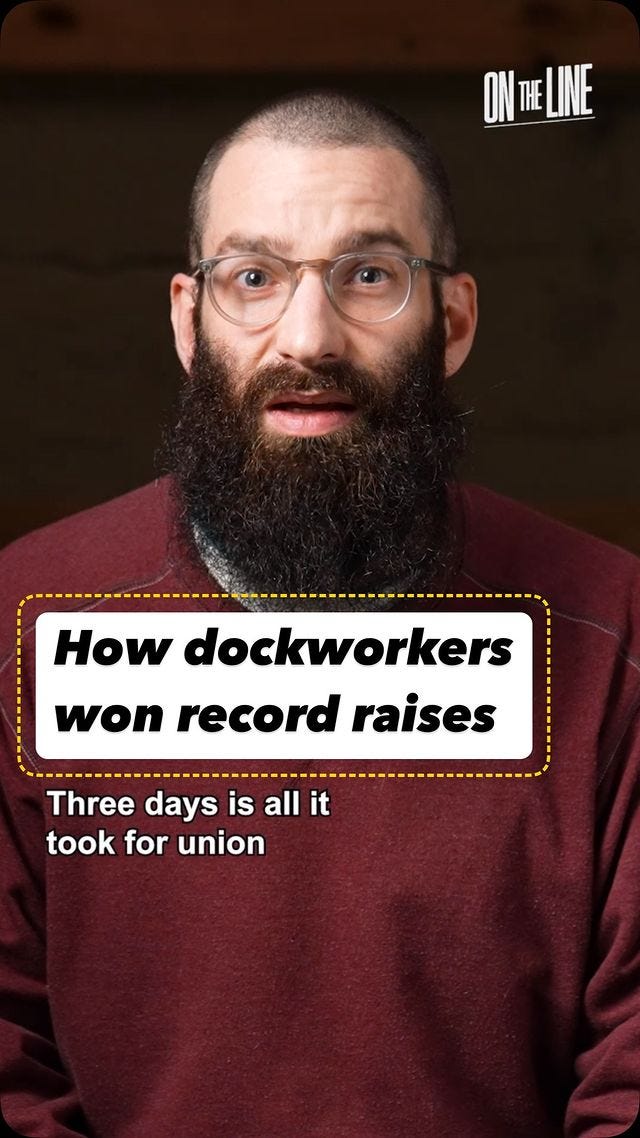Three days is all it took for union dockworkers to make the bosses across the country shake in the face of their power. Against all odds, they secured major victories in their contract fight, including a 62% raise, so let’s talk about what happened in those few long days on the docks.
It was the first coast-wide strike by the International Longshoremen’s Association, or ILA, since 1977. On the other side of the bargaining table, the United States Maritime Alliance, or USMX, represents the major shipping lines and port operators along the entirety of the East and Gulf coast ports of the US.
USMX has been playing games for a long time though, with their last offer to ILA before the eve of the strike coming all the way back in February, 2023. They showed no serious effort to reach a deal and were even blatantly violating the existing contract provisions on automation in the port of Mobile, Alabama. In reality, USMX was playing chicken with the prospect of a strike and leaving the ILA with no choice but to force the shipping giants back to the table.
As soon as the strike kicked off at midnight of Oct 1st, the enemies of the workers lined up behind USMX to demonize and conspire against the dockworkers strike as it was dealing serious damage to the bosses’ interests all across the country, costing them up to an estimated $5 billion a day.
The corporate media was up first – with plenty of crocodile tears. They bemoaned how the dockworkers strike could have ripple effects across the economy, impacting working families around the country, undermine recovery efforts from the devastation of hurricane Helene, or even “ruin Christmas.”
Newscaster: “I also don’t understand how the unions have such power and control over all these ports. You know, to be able to put a strike like this in place and put the economy at risk just seems pretty insane to me”
Somehow, this coverage always failed to mention who was actually responsible for this: USMX. USMX had failed to negotiate for months or even to recognize the basic struggles of dockworkers themselves, instead painting them as the enemy of all working people. They rarely mention how the shipping companies raked in $400 billion in record profits between 2020 and 2023, all while the longshoremen kept the docks running through the global pandemic and faced record inflation themselves.
These same corporate media outlets apparently just became aware of the issues of working families, since we almost never see them speak on the real struggles of working families crushed by inflation and a deepening recession today. Nor did they speak out against the criminal underfunding of disaster response from either the federal government or the states hit by Helene or other natural disasters.
Working behind the scenes against the strike, and representing all the largest corporations in the country was the National Association of Manufacturers, or NAM, along with countless Chambers of Commerce across the country. NAM has worked for nearly a 130 years to shape government policy to be as pro-business as possible. The executive board of NAM is a who’s-who of the largest corporations in the country – from pharmaceuticals to oil to auto to construction to home goods to food, it’s essentially the clearing house of all corporate interests.
So we shouldn’t be surprised that they pushed hard for the federal government to end the strike by invoking the Taft-Hartley Act, which was passed in 1947 to contain and hamstring the labor movement by both limiting both strike activity and the political agenda of unions. Get this though, NAM is actually the same organization that bankrolled and led the campaign for the passage of Taft-Hartley back in 1947, too! No wonder they are so eager to put it to use, it’s like they were trying to dust off their favorite tool and pushing the government to just give it a try.
Perhaps most dramatically though, on the last day of the strike, we saw Florida Governor Ron DeSantis desperately attempt to break the strike by calling in the National Guard and Florida State Guard to “protect and operate” the ports in Florida. Anyone who knows their history could see he was only courting disaster on the docks. During the Great Postal Strike of 1970 when 210,000 postal workers launched a nationwide wildcat strike, a desperate President Nixon tried to use the national guard and the military to break the strike, which failed spectacularly Reporter: What exactly are you doing? National Guard member: I don’t really know! —and ended with the victory of the postal workers. The worst case scenario then was some missorted mail and papercuts, but things would have looked much worse on the docks.
Dockworkers move tens of millions of tons of cargo daily with specialized equipment, and despite their expertise and experience, this is still extremely dangerous work. Too often dockworkers face life altering or even deadly accidents. The national guard with no training attempting to take on this work would absolutely have led to accidents which would have caused millions in damage and completely avoidable injuries and deaths. All so DeSantis could make a political stand against the strike.
While all of this unfolded, the dockworkers pressed on! Their strike dealt major damage against the shipping giants and turned up the heat across the entire political and economic system to nearly a boiling point, leading even the federal government to call on the companies to come back to the table.
Finally, the companies caved to the central demands for higher wages, granting an incredible 62% raise over the life of the contract, bringing top pay from $39 to $63 per hour. That will be life changing for dockworkers and their families across the whole country.
Now the contract has been extended for 90 days, with the new expiration on January 15th, 2025. The main issues of fighting against automation remain unresolved at the table and the ink on the contract won’t dry until that fight plays out. After the dockworkers have made crystal clear the power that they have to shut down the ports and send ripples through the country, USMX will have to take this final stage of bargaining a lot more seriously, or risk awakening a sleeping giant once again. The fight for job security will definitely not end here, and this may just be one of the first major battles. We must all prepare for the true war ahead to secure the futures of all working people.






When containerization happened in the 50's and 60's, the ILA went from 10s of thousands of jobs down to 3.5K in NY. However, after several strikes, workers won as big a victory as possible with with new technology. They won a "Guaranteed Annual Income" for all existing longshore workers that lasted for two generations, they won organizing rights w/in 50miles of the ports on containerized cargo (AKA the 50 mile rule), and they won a permanent cut of productivity gains through their "Container Royalty Fund." These victories should be celebrated as a model and not forgotten. (The 50 mile rule was later struck down, but workers had won it in the contract.)